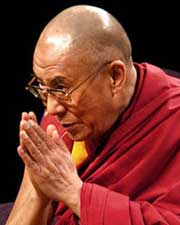Dalai Lama Gets Meditation Lesson
By Dan Orzech, Wired News, Nov 30, 2005
The Dalai Lama was in Washington, D.C., earlier this month, meeting with President Bush, giving a public talk on the subject of global peace -- and learning about meditation from Western scientists.
 Wearing the traditional scarlet robes of a Tibetan monk and a bright orange eye shade emblazoned with a golf-company logo, the 70-year-old leader of Tibetan Buddhism listened intently as researchers at a conference on science and meditation described a growing body of research on the effects of meditation on the brain and the body.
Wearing the traditional scarlet robes of a Tibetan monk and a bright orange eye shade emblazoned with a golf-company logo, the 70-year-old leader of Tibetan Buddhism listened intently as researchers at a conference on science and meditation described a growing body of research on the effects of meditation on the brain and the body.
The conference is the latest in a series of dialogues between the Dalai Lama and Western scientists that have taken place since 1987. Organized by the Mind & Life Institute, the conversations were private -- mostly taking place in the Dalai Lama's living room in India -- until 2003, when they were held in front of an audience at the Massachusetts Institute of Technology.
Scientists present at this month's meeting included Richard Davidson, a Harvard University-trained neuroscientist who has done pioneering research on Buddhist monks, and Robert Sapolsky, a Stanford University professor who studies the effects of stress on the body. They told the Dalai Lama, winner of the Nobel Peace Prize, and an audience of 2,500 about recent experiments showing meditation can strengthen the immune system, prevent relapse in people with depression and lower cortisol levels. Cortisol is a hormone associated with stress.
All this is pushing the envelope of contemporary neuroscience. "It came as a great surprise to (scientists) that there were such clear neural correlates of meditative states," said Wolf Singer, the director of Germany's Max Planck Institute for Brain Research in Frankfurt, who also addressed the conference.
It's also pushing buttons for some scientists. The Dalai Lama's D.C. trip included a controversial keynote address to the annual meeting of the Society for Neuroscience. Calling the Dalai Lama a "religious symbol with a controversial political agenda," a number of neuroscientists urged the group to cancel his talk. An online petition opposing the talk turned into a forum for neuroscientists on both sides of the issue to weigh in.
The research is taking neuroscientists into realms not often studied in Western labs. Davidson's team at the University of Wisconsin, for example, is exploring what states like compassion or happiness look like in the brain.
His research shows that Buddhist monks doing a meditation that evokes feelings of compassion exhibit very specific changes in a part of the brain called the amygdala.
While much of Davidson's research has been on Buddhist monks with decades of meditation experience, he has also found significant changes in beginning meditators.
Davidson and another conference speaker, Jon Kabat-Zinn, taught employees at a biotech firm a form of meditation called Mindfulness-Based Stress Reduction. After eight weeks, the researchers reported that workers who had received the meditation training had a stronger immune-system response than control subjects, based on their antibody response to a flu vaccination.
While Western researchers are exploring the effects of meditation on physical health, Alan Wallace, a leading Tibetan scholar and one of the Dalai Lama's translators, pointed out that when faced with physical ailments, Tibetans traditionally turned to doctors or healers, not to meditation.
The purpose of meditation, added the Dalai Lama, is not to cure physical ailments, but to free people from emotional suffering.

 Wearing the traditional scarlet robes of a Tibetan monk and a bright orange eye shade emblazoned with a golf-company logo, the 70-year-old leader of Tibetan Buddhism listened intently as researchers at a conference on science and meditation described a growing body of research on the effects of meditation on the brain and the body.
Wearing the traditional scarlet robes of a Tibetan monk and a bright orange eye shade emblazoned with a golf-company logo, the 70-year-old leader of Tibetan Buddhism listened intently as researchers at a conference on science and meditation described a growing body of research on the effects of meditation on the brain and the body.